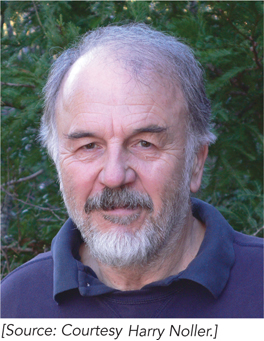Chapter Introduction
18: Protein Synthesis
617
18.1 The Ribosome
18.2 Activation of Amino Acids for Protein Synthesis
18.3 Initiation of Protein Synthesis
18.4 Elongation and Termination of the Polypeptide Chain
18.5 Translation-Coupled Removal of Defective mRNA
18.6 Protein Folding, Covalent Modification, and Targeting
MOMENT OF DISCOVERY

The defining moment in my career was the realization that ribosomal RNA, not protein, was the functionally important component of the ribosome—and this discovery was somewhat serendipitous. My plan when starting my laboratory, at the University of California, Santa Cruz, was to apply my training in protein biochemistry to investigating the function of ribosomal proteins. We began treating ribosomes with chemicals known to inactivate protein enzymes, hoping to recover nonfunctional ribosomes that could be analyzed to determine which proteins had been affected and thereby discover those responsible for activity. The problem was, the ribosome withstood nearly all the standard chemical treatments we tried!
An unexpected result from one experiment led me to suggest to an undergraduate researcher, Brad Chaires, to try the RNA-
When Brad graduated, I followed up with reconstitution experiments showing that it was, in fact, the ribosomal RNA that had been functionally inactivated, and that tRNA could protect ribosomes from kethoxal inactivation. Protection resulted from the tRNA binding to the ribosome and blocking kethoxal’s access to parts of the rRNA, so they couldn’t be chemically modified. These results led us to propose that ribosomal RNA, rather than ribosomal protein, was responsible for the functional activity of the ribosome. Many colleagues considered this “a crackpot idea,” which I found frustrating but, in the antiestablishment spirit of the 1970s, also motivating.
Our findings led us to sequence the ribosomal RNAs (which Carl Woese referred to as “Sacred Scrolls”), and we were excited to find that the sites of chemical inactivation corresponded to the most evolutionarily conserved parts of rRNA. We then embarked on a fruitful collaboration with Woese to determine the secondary structures of the ribosomal RNAs, which ultimately led us in the direction of working out the three-
—Harry Noller, on discovering the functional importance of ribosomal RNA
618
The synthesis of proteins is the final step in the flow of genetic information, beginning with DNA replication and continuing with transcription into mRNA. Because of the abundance of proteins—
The transfer of information from the 4-
In Chapter 17 we introduced the genetic code and the mechanism of decoding by tRNAs. In this chapter, we discuss the structures and activities of ribosomes and aminoacyl-